2007 BMW MOTORRAD G 650 XCOUNTRY ESP
[x] Cancel search: ESPPage 37 of 126
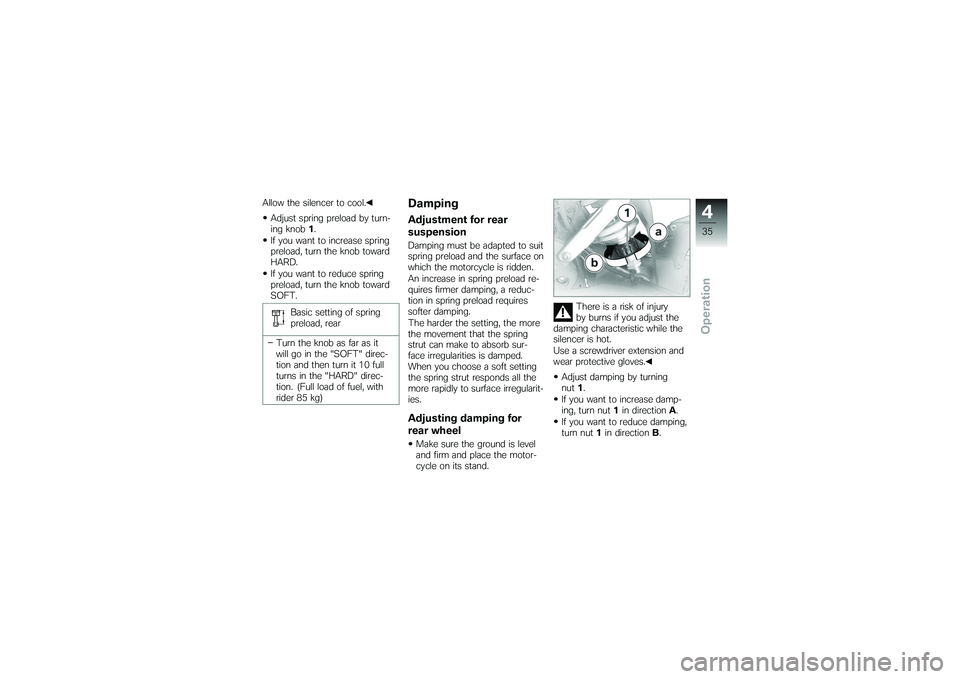
Allow the silencer to cool.Adjust spring preload by turn-
ing knob 1.
If you want to increase spring
preload, turn the knob toward
HARD.
If you want to reduce spring
preload, turn the knob toward
SOFT.
Basic setting of spring
preload, rear
Turn the knob as far as it
will go in the "SOFT" direc-
tion and then turn it 10 full
turns in the "HARD" direc-
tion. (Full load of fuel, with
rider 85 kg)
DampingAdjustment for rear
suspensionDamping must be adapted to suit
spring preload and the surface on
which the motorcycle is ridden.
An increase in spring preload re-
quires firmer damping, a reduc-
tion in spring preload requires
softer damping.
The harder the setting, the more
the movement that the spring
strut can make to absorb sur-
face irregularities is damped.
When you choose a soft setting
the spring strut responds all the
more rapidly to surface irregularit-
ies.Adjusting damping for
rear wheelMake sure the ground is level
and firm and place the motor-
cycle on its stand. There is a risk of injury
by burns if you adjust the
damping characteristic while the
silencer is hot.
Use a screwdriver extension and
wear protective gloves.
Adjust damping by turning
nut 1.
If you want to increase damp-
ing, turn nut 1in direction A.
If you want to reduce damping,
turn nut 1in direction B.
435zOperation
Page 48 of 126
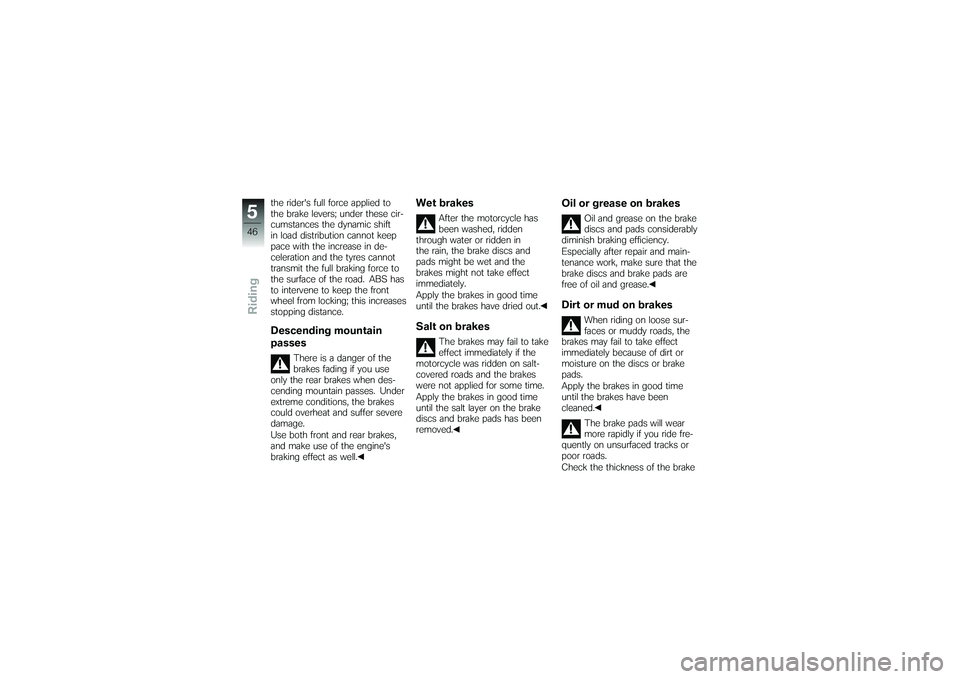
the rider's full force applied to
the brake levers; under these cir-
cumstances the dynamic shift
in load distribution cannot keep
pace with the increase in de-
celeration and the tyres cannot
transmit the full braking force to
the surface of the road. ABS has
to intervene to keep the front
wheel from locking; this increases
stopping distance.Descending mountain
passes
There is a danger of the
brakes fading if you use
only the rear brakes when des-
cending mountain passes. Under
extreme conditions, the brakes
could overheat and suffer severe
damage.
Use both front and rear brakes,
and make use of the engine's
braking effect as well.
Wet brakes
After the motorcycle has
been washed, ridden
through water or ridden in
the rain, the brake discs and
pads might be wet and the
brakes might not take effect
immediately.
Apply the brakes in good time
until the brakes have dried out.
Salt on brakes
The brakes may fail to take
effect immediately if the
motorcycle was ridden on salt-
covered roads and the brakes
were not applied for some time.
Apply the brakes in good time
until the salt layer on the brake
discs and brake pads has been
removed.
Oil or grease on brakes
Oil and grease on the brake
discs and pads considerably
diminish braking efficiency.
Especially after repair and main-
tenance work, make sure that the
brake discs and brake pads are
free of oil and grease.
Dirt or mud on brakes
When riding on loose sur-
faces or muddy roads, the
brakes may fail to take effect
immediately because of dirt or
moisture on the discs or brake
pads.
Apply the brakes in good time
until the brakes have been
cleaned.
The brake pads will wear
more rapidly if you ride fre-
quently on unsurfaced tracks or
poor roads.
Check the thickness of the brake
546zRiding
Page 52 of 126
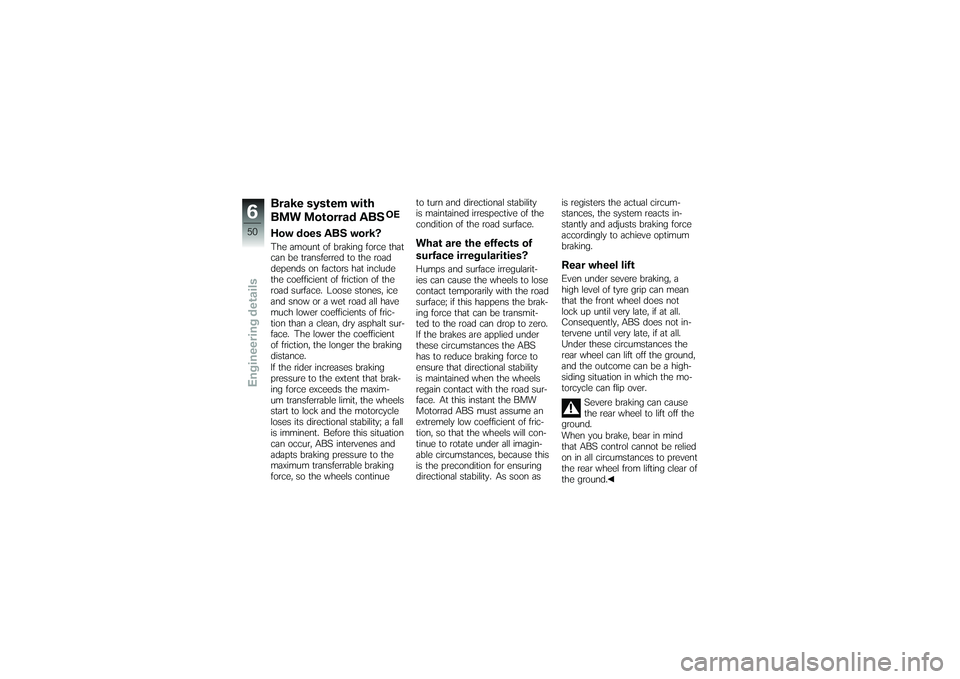
Brake system with
BMW Motorrad ABS
OE
How does ABS work?The amount of braking force that
can be transferred to the road
depends on factors hat include
the coefficient of friction of the
road surface. Loose stones, ice
and snow or a wet road all have
much lower coefficients of fric-
tion than a clean, dry asphalt sur-
face. The lower the coefficient
of friction, the longer the braking
distance.
If the rider increases braking
pressure to the extent that brak-
ing force exceeds the maxim-
um transferrable limit, the wheels
start to lock and the motorcycle
loses its directional stability; a fall
is imminent. Before this situation
can occur, ABS intervenes and
adapts braking pressure to the
maximum transferrable braking
force, so the wheels continueto turn and directional stability
is maintained irrespective of the
condition of the road surface.
What are the effects of
surface irregularities?Humps and surface irregularit-
ies can cause the wheels to lose
contact temporarily with the road
surface; if this happens the brak-
ing force that can be transmit-
ted to the road can drop to zero.
If the brakes are applied under
these circumstances the ABS
has to reduce braking force to
ensure that directional stability
is maintained when the wheels
regain contact with the road sur-
face. At this instant the BMW
Motorrad ABS must assume an
extremely low coefficient of fric-
tion, so that the wheels will con-
tinue to rotate under all imagin-
able circumstances, because this
is the precondition for ensuring
directional stability. As soon as
is registers the actual circum-
stances, the system reacts in-
stantly and adjusts braking force
accordingly to achieve optimum
braking.
Rear wheel liftEven under severe braking, a
high level of tyre grip can mean
that the front wheel does not
lock up until very late, if at all.
Consequently, ABS does not in-
tervene until very late, if at all.
Under these circumstances the
rear wheel can lift off the ground,
and the outcome can be a high-
siding situation in which the mo-
torcycle can flip over.
Severe braking can cause
the rear wheel to lift off the
ground.
When you brake, bear in mind
that ABS control cannot be relied
on in all circumstances to prevent
the rear wheel from lifting clear of
the ground.
650zEngineering details
Page 64 of 126
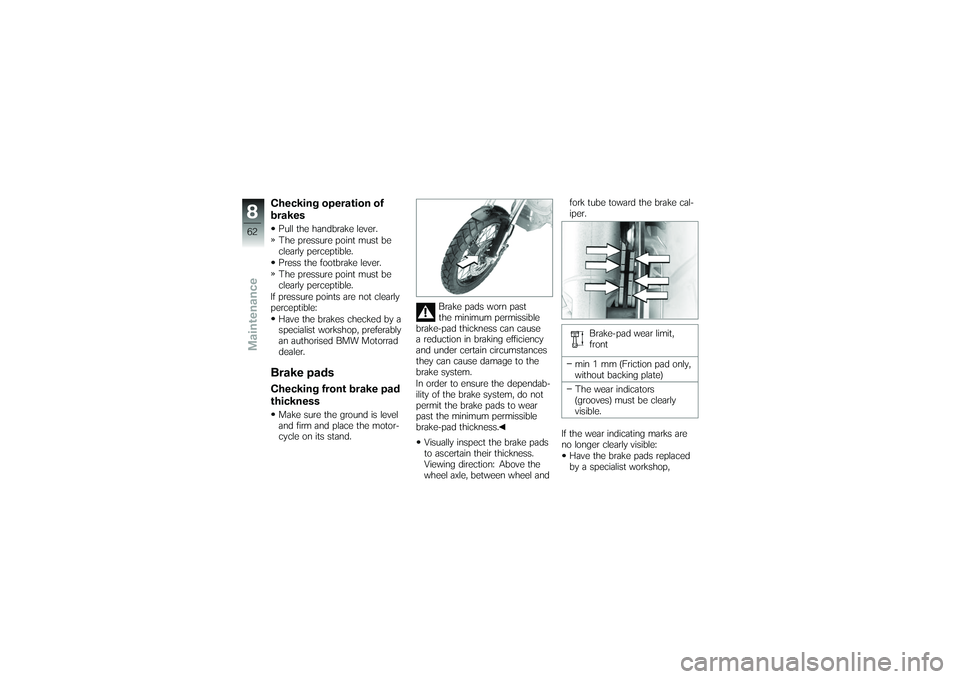
Checking operation of
brakesPull the handbrake lever.
The pressure point must be
clearly perceptible.
Press the footbrake lever.
The pressure point must be
clearly perceptible.
If pressure points are not clearly
perceptible: Have the brakes checked by a
specialist workshop, preferably
an authorised BMW Motorrad
dealer.Brake padsChecking front brake pad
thicknessMake sure the ground is level
and firm and place the motor-
cycle on its stand. Brake pads worn past
the minimum permissible
brake-pad thickness can cause
a reduction in braking efficiency
and under certain circumstances
they can cause damage to the
brake system.
In order to ensure the dependab-
ility of the brake system, do not
permit the brake pads to wear
past the minimum permissible
brake-pad thickness.
Visually inspect the brake pads
to ascertain their thickness.
Viewing direction: Above the
wheel axle, between wheel and fork tube toward the brake cal-
iper.
Brake-pad wear limit,
front
min 1 mm (Friction pad only,
without backing plate)
The wear indicators
(grooves) must be clearly
visible.
If the wear indicating marks are
no longer clearly visible: Have the brake pads replaced
by a specialist workshop,
862zMaintenance
Page 96 of 126
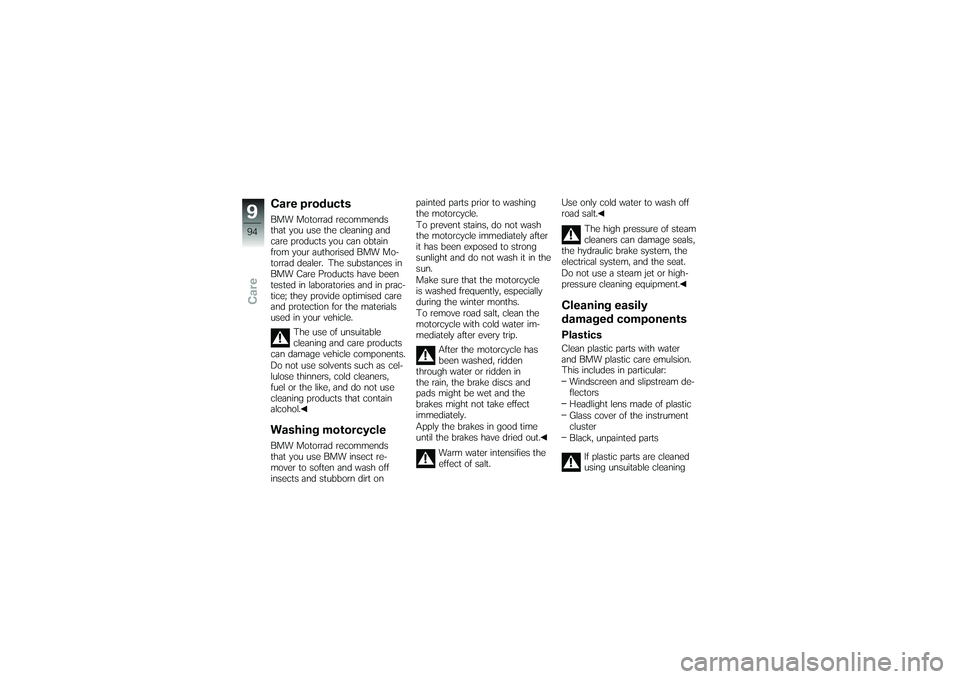
Care productsBMW Motorrad recommends
that you use the cleaning and
care products you can obtain
from your authorised BMW Mo-
torrad dealer. The substances in
BMW Care Products have been
tested in laboratories and in prac-
tice; they provide optimised care
and protection for the materials
used in your vehicle.The use of unsuitable
cleaning and care products
can damage vehicle components.
Do not use solvents such as cel-
lulose thinners, cold cleaners,
fuel or the like, and do not use
cleaning products that contain
alcohol.Washing motorcycleBMW Motorrad recommends
that you use BMW insect re-
mover to soften and wash off
insects and stubborn dirt on painted parts prior to washing
the motorcycle.
To prevent stains, do not wash
the motorcycle immediately after
it has been exposed to strong
sunlight and do not wash it in the
sun.
Make sure that the motorcycle
is washed frequently, especially
during the winter months.
To remove road salt, clean the
motorcycle with cold water im-
mediately after every trip.
After the motorcycle has
been washed, ridden
through water or ridden in
the rain, the brake discs and
pads might be wet and the
brakes might not take effect
immediately.
Apply the brakes in good time
until the brakes have dried out.
Warm water intensifies the
effect of salt. Use only cold water to wash off
road salt.
The high pressure of steam
cleaners can damage seals,
the hydraulic brake system, the
electrical system, and the seat.
Do not use a steam jet or high-
pressure cleaning equipment.
Cleaning easily
damaged componentsPlasticsClean plastic parts with water
and BMW plastic care emulsion.
This includes in particular:
Windscreen and slipstream de-
flectors
Headlight lens made of plastic
Glass cover of the instrument
cluster
Black, unpainted parts
If plastic parts are cleaned
using unsuitable cleaning
994zCare
Page 97 of 126

agents, the surfaces can be dam-
aged.
Do not use cleaning agents that
contain alcohol, solvents or ab-
rasives to clean plastic parts.
Even fly-remover pads or clean-
ing pads with hard surfaces can
produce scratches.Soften stubborn dirt and
insects by covering the af-
fected areas with a wet cloth.ChromeUse plenty of water and BMW
shampoo to clean chrome, par-
ticularly if it has been exposed to
road salt. Use chrome polish for
additional treatment.RadiatorClean the radiator regularly to
prevent overheating of the en-
gine due to inadequate cooling.
For example, use a garden hose
with low water pressure. Cooling fins can be bent
easily.
Take care not to bend the fins
when cleaning the radiator.
RubberTreat rubber components with
water or BMW rubber-care
products.
Using silicone sprays for
the care of rubber seals can
cause damage.
Do not use silicone sprays or
other care products that contain
silicon.Paint careWashing the motorcycle regularly
will help counteract the long-term
effects of substances that dam-
age the paint, especially if your
motorcycle is ridden in areas
with high air pollution or natural
sources of dirt, for example tree
resin or pollen. Remove particularly aggressive
substances immediately, how-
ever, as otherwise the paint can
be affected or become discol-
oured. Substances of this nature
include spilt fuel, oil, grease,
brake fluid and bird droppings.
We recommend BMW vehicle
polish or BMW paint cleaner for
this purpose.
Marks on the paintwork are par-
ticularly easy to see after the
motorcycle has been washed.
Remove stains of this kind im-
mediately, using cleaning-grade
benzene or petroleum spirit on a
clean cloth or ball of cotton wool.
BMW Motorrad recommends
BMW tar remover for removing
specks of tar. Remember to wax
the parts treated in this way.
995zCare
Page 107 of 126

Rear wheel
Rear wheel typeSpoked wheel
Rear wheel rim size 3.00" x 17"
Tyre designation, rear 130 / 80 - 17
Tyre pressures
Tyre pressure, front 1.9 bar, one-up, tyre cold
2 bar, two-up and/or with luggage, tyre cold
Tyre pressure, rear 2.1 bar, one-up, tyre cold
2.3 bar, two-up and/or with luggage, tyre coldElectricsElectrical rating of on-board socket
with OE BMW Motorrad ABS or with OA
Power socket: 5A
Fuses Plug-in "Minifuses" with ratings of 7.5 A and 15 A with OE BMW Motorrad ABS: Plug-in "Minifuses" with ratings of 10 A, 20 A and 30 A
10105zTechnical data